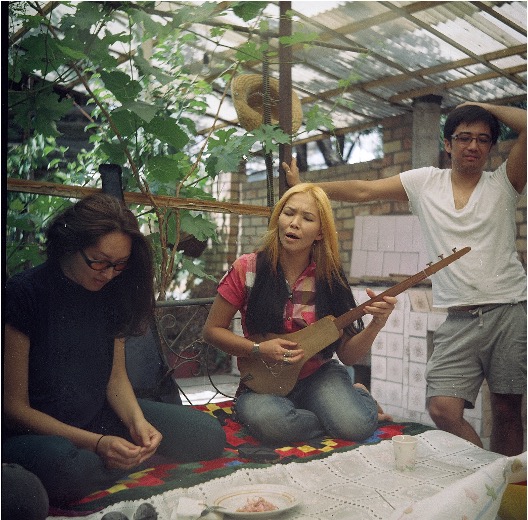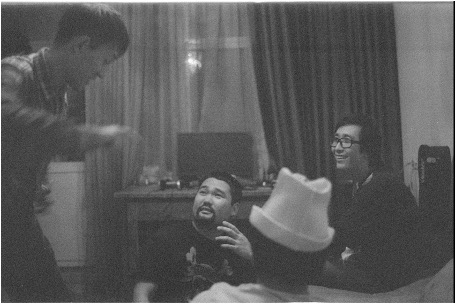beuys on/off project caught me unaware. For the last two decades, I’ve been engaged in the work of empowering and sustaining grassroots communities in Central Asia and across Eurasia. I dwell among local cultural practitioners whose work is deeply embedded in manifold Central Asian narratives. For me, the sense of ownership is a key to each project to last longer than its executive cycle, especially within those initiated outside of Central Asia. In and among the many overlapping and contesting cultural workers communities we form, it is far too common to encounter ‘international’ expert practitioners who are profoundly ignorant of the particulars of Central Asia, alternating between understandings of the region based on either fanciful takes from imperial explorer texts of the 18th century and the leveling modernist textbooks that posit Central Asia as simply another divisible unit in the geopolitical order.

It is with some pleasure then that I embrace the chance to greet and talk with the ghosts of Joseph Beuys whose legacy of social sculpture continues with a life of its own. Beuys also passionately challenged key institutional norms and contributed to or even founded artistic canons of different ethics – like those of universal access to art education and transnational concepts of ecological respect and protection. However, is his idea of ‘EURASIA’ worth revisiting? Perhaps so. His myth is not only a narrow storyline, but also divorced from an embodied daily reality to the extent that today it affords us an opportunity not only to reject that mythical formulation, but elide it all together and use that legacy’s materiality for the actually existing and still-dreamed of potential for social sculpture in Central Asia.
Typical among his Western contemporaries of the twentieth century, Beuys’ ideas of ‘EURASIA’ and his invented, ahistorical practices of Eurasia-derived shamanism and nomadism have little basis in researched factual practices, genealogical relationships with established practitioners, or even amateur observations from stays of any duration in their claimed generative region(s). Again like many of his contemporaries, his oeuvre is full of preoccupations with pseudoscientific theory and specious new age spirituality. Still, Beuys’ innovation of strategically upscaling art to physically deny the potential of its sitting in a staid gallery and his use of materials, like felt and fat, which cannot be practically stored in museums, endures and still shapes present-day artistic practices. Thus Beuys’ ‘art’ as not contained and statically preserved, but experienced – lived – and in the best cases amplified at the level of society and ecosystem is an enduring legacy worth praise.
On a personal level, I am struck by Beuys’ practice of sincere interest in fellow artists. His biographies and interviews present him as a person who walks up another without intending small talk, only forcefully digging into the other’s narrative and pushing for their recognition of a capacity to make art based on their experience. Beuys himself agitated for artists to shift their practices and locate a generative cause or source of their work in their immediate environment. Beuys executed the same thrust in his educational practice: he sought to demystify the artist-as-artist by stripping the artist of any romantic divine role and insisting that everyone can be an artist. And yet, contradiction: his own self-mystification and mythopoetic generative impulses are an enduring part of his legacy.

The fallacies of Joseph Beuys then are where we should depart. The legendary Crimean Tatar encounter and rescue has a conceptual counterpoint in the accident of mine and Dominique Chen’s current collaboration. Dominique’s intention to revisit Joseph Beuys’ ideological proposition of ‘EURASIA’ here comes to fruition not in Ukraine and with the Crimean Tatars Beuys probably never met, but rather through a call for interest passed on through listservs and curated email-forwarding through contacts of contacts, with one of the threads picked up by a motivated officer in Goethe-Institut Kazakhstan who reached out to me personally. As co-leads of the EURASIA program brought together through happenstance or perhaps through a tertiary function of sharing similar culinary interests and having wildly divergent areas of knowledge expertise which itself created a point of curiously productive frisson, Dominique and I will from now on intentionally depart from exciting misunderstanding, generative confusion, and celebrated ignorance. An interdisciplinary endeavor by artists and scholars from Japan and Korea, funded by a German institute, and with a global audience is a good excuse as any to leverage Beuys’ legacy in challenging dualist categories of appropriation and diffusion, and even more to attempt an amplification of our meaningful intersubjectivities and practices beyond myths, fantasies, and fallacies about people and peoples of so called Eurasia, Central Asia, and East Asia in particular.
Further to celebrated ignorance: unlike the philosopher and his shoemaker, engaging regionally-based artisans in this project is essential for me. Artisans are always contemporary, their art is embedded in social and cultural context, their art is lived and tells stories. Folk art is often a collective effort and informed by the ecosystems from which they emerge. Applied arts precede and exceed social sculpture. Often the craft is acquired as part of upbringing and informal education, entangled in rituals, customs, practiced skill, and routines. As Beuys might appreciate, everyone can become a folk artist. In equal conversation with artisans, artists, cultural practitioners, and scholars, Dominique and I will document a complexly heterogeneous Eurasia. We hope to unfold socio-cultural commonalities that have been omitted by geopolitically constructed differences and stories of intergenerational livelihoods, including our own, that borders and stereotypes have thus far failed to rationalize.
Dominique Chen is not only a profoundly kind and curious person endeavouring to re-inscribe Beuys’ EURASIAnality with and by Eurasians, but a researcher committed to building and rebuilding a network of people across and through continents far exceeding any mythical map place called Eurasia. Much has already been written, said, filmed, and otherwise recorded on Beuys, who made of our Eurasian people’s common felt and fat a fetish material fit for provocations in high concept galleries. For me then (and likely for Beuys himself, if his radical -for the art world- position is not to be lost in the mounds of normalizing and sanitizing material produced about him), Beuys’ work is best summed up by the moth-devoured felt suit piece dissolving in the Tate’s collection.
Joseph Beuys’ Felt Suit | Lost Art by Tate, 2015 (on Tate Youtube)
Undone by artifice and an absence of culturally continuous production, Beuys’ suit disintegrates, unlike Central Asian feltwork made to have an everyday presence and use that outlives its immediate maker often across generations. Beuys as a particular point in a particular history can and should be noted, and then, with the mystifying incantations said, we can take a breath and look around us to see where we stand today.
- License:
- CC-BY

